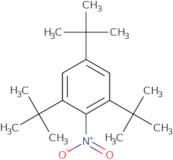2,4,6-Tri-tert-butylnitrobenzene
CAS: 4074-25-3
Rif. 3D-EAA07425
| 1g | Fuori produzione | ||
| 5g | Fuori produzione | ||
| 10g | Fuori produzione | ||
| 25g | Fuori produzione | ||
| 50g | Fuori produzione |
Informazioni sul prodotto
- 1,3,5-Tris(1,1-dimethylethyl)-2-nitrobenzene
- 1,3,5-Tritert-butyl-2-nitrobenzene
- 2,4,6-Tri-Tert-Butylnitrobenzene
- 2,4,6-Tri-tert-butyl-1-nitrobenzene
- Benzene, 1,3,5-tri-tert-butyl-2-nitro-
- Benzene, 1,3,5-tris(1,1-dimethylethyl)-2-nitro-
- 1,3,5-Tri-tert-butyl-2-nitrobenzene
2,4,6-Tri-tert-butylnitrobenzene is a functional theory that can be used to predict the vapor pressure of organic compounds. The theory is based on the assumption that the solvents are ideal and that all reactions are reversible. The vapor pressure of an organic compound is determined by the number of moles of molecules present in a given volume and the temperature at which it is measured. The Grignard reagent reacts with 4-nitroacetophenone to produce 2,4,6-tri-tert-butylnitrobenzene as well as other products. This reaction has been studied in both solid state and liquid phase. In solid state, the reaction proceeds via a strain mechanism while in solution it proceeds through a photocyclization mechanism. The addition law for chemical reactions states that if two reactions occur in series (i.e., A + B → C) then they will have an additive effect on each other





